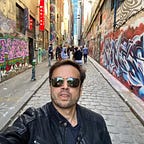Unattainable
Is AI Mankind’s Quest to Attain the Unattainable?
Your trials did not come to punish you but to awaken you — Parmahansa Yogananda
I Still Haven’t Found What I am Looking For
I have followed the work of Walter Isaacson for years. He’s covered some of the most mercurial humans on the planet — people such as Steve Jobs and Elon Musk. Isaacson has also written biographies of polymaths such as Leonardo daVinci and Ben Franklin. Finally, he’s written biographies of dreamers such as Einstein — considered by many as the one of greatest minds of the century. Then there is the biography of Jennifer Doudna that I am yet to read. However, of all the book covers that adorn Isaacson’s works, none is more haunting to me than the cover of Steve Jobs’ biography.
I was reminded of that book cover when I was watching a documentary on Jobs’ life on HBO Max. I could sense the feeling of a life incomplete. As the documentary progressed further and covered his work at Pixar and Apple, I couldn’t help but wonder : what was Jobs’ searching for? By extension, what drives most brilliant people? Is their drive a result of a foregone conclusion i.e. try as they might, they might not achieve the thing they are looking for?
Let me rephrase the question. Is the relentless and single minded pursuit of artists, scientists, engineers, mathematicians, musicians and most humans a search for the same thing? The intensity of that pursuit (drive) may vary. I don’t know the answer. However, I have a vague feeling that all of us are searching for something that we can sense (towards the end of our lives) as unattainable. Today, that search manifests itself in creating an imperfect image of ourselves in the form of Artificial Intelligence (AI). Think about it. It is not surprising that we are our own muse.
A Quest Called Artificial Intelligence (AI)
I first read about Professor Kevin — the world’s first Cyborg in the year 2000. I was fascinated by his quest to create the ultimate human computer interface by implanting a chip in his body. Neuralink came much later. We have been toying with hardware for a long time. From implants to Virtual Reality (VR), Augmented Reality(AR), Mixed Reality (MR) to the latest — Apple’s Spatial Conputing, we have always wanted to extend the human body (hardware).
On the software side, we have toyed with mimicking the human brain in the form of Artificial Intelligence. Coined in 1956 by John McCarthy the term AI has taken a life of its own. Today, it has come to signify our attempts at creating neural networks and synapses much like the ones in the human brain. Thousands of engineers, computer programmers and people from all walks of life — linguists, ethicists, neuroscientists across the globe are collaborating often with the backing of private corporations to advance humanity to its goal of replicating itself in machines.
Generative AI in the form of Large Language Models such as Chat GPT-4 or multimodal models such as Google’s Bard is the state of the art today. The rate at which these models are growing is exponential. Yet, we have not reached Artificial General Intelligence i.e. the ability to solve unstructured, multidisciplinary problems that humans thrive at solving.
The kinds of problems that geniuses such as Jobs, Einstein, Ben Franklin and DaVinci have been working on in their own disciplines — from Graphical User Interfaces to The Theory of Relativity and the Mona Lisa, each creator provided structure to unstructured problems and advanced humanity.
They were searching for a goal higher than AGI. Therefore, our quest to create AI has a limited goal — super intelligence perhaps consciousness. However, what has motivated humans lies beyond consciousness. Our goal is to understand the true nature of reality. AI cannot attain the unattainable — it can come close. AGI and artificial consciousness can help us meditate and understand what it is to be truly human. AI will help us on our own journey to understand reality — an alternate to mysticism.
One Truth, Many Paths
Steve Jobs was one of a kind. His search for what is unattainable drove him to attain maniacal perfection. In a similar vein, scientists like Albert Einstein, artists such as Leonardo Da Vinci and creators like Steve Jobs were driven by their quest to attain a full understanding of the one true nature of reality which eluded them. Their artistry constantly elevated their pursuit of the one truth — described in Vedic literature as “the truth is one, the wise call it by many names”. Mystics around the world also search for the true nature of reality albeit using different means ie spiritual techniques.
If AI is our endeavor to attain the unattainable, AI’s greatest achievement will be its imperfection. Perfection is becoming a human (a human that is capable of seeking and obtaining an understanding of the true nature of reality). For AI, that goal is unattainable.
